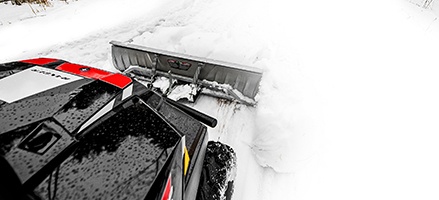
ATV-UTV Snow Plowing Tips for First-Timers
Ready to have some fun plowing snow with your ATV/UTV this winter?If it’s your first time plowing with an ATV/UTV, there are a few things that are helpful to know before you start. With a little practice, you’ll figure out what works best for you, but here are some tips to save you from learning everything the hard way:
- Plow with the Storm
The most important thing to remember is to plow with the storm! Don’t wait until there’s 10 inches of wet, heavy snow on the ground before starting to plow. An ATV/UTV can handle just about any winter storm, but the key is to start early. The heavier and deeper the snow, the harder it’s going to be on your vehicle, so when a big storm blows through, don’t wait until it’s over to start on the driveway.
TIP- Plowing soft surfaces: We have found that having a thin layer of packed snow on a soft surface such as dirt or gravel really helps. Drive a vehicle back and forth over the snow first and let it pack down between 1 to 2 inches before plowing.
- Don’t Ram It
Treat your ATV/UTV and plow equipment with respect. Ramming into hard-packed mounds of snow can bend the plow blade, damage the vehicle and cause injury to the rider or passenger. Plowing at high speeds is also dangerous, as there can be hidden objects or a buildup of ice underneath the snow. Running into these obstacles at high speeds could seriously damage the vehicle or cause injury to the rider or passenger. If you need to plow a large drift, lift up the blade (but not all the way) and plow the top half. Then come back and plow the bottom half.
- Clear a Wider Path
Push the snow out into the yard at the beginning of the season, so that by the end of the season, you still have a full width of driveway to plow. Come February, you don’t want to find that you have nowhere left to push the snow! To keep from ripping up the yard, lift up the blade a couple inches to skim the grass or lower the skid shoes to raise the blade.
- Get a Grip
If you need extra traction and stability, secure some weight to the back of the ATV/UTV and invest in some tire chains.
- Inspect, Inspect, Inspect
Don’t assume your plow will always work perfectly. Regardless of which system you select, you must examine it before, during and after each usage. Inspect before you plow for loose parts or winch cable damage, for example. Inspect it while you plow to prevent ice buildup, which can make pushing snow more difficult. Finally, inspect after you plow so you know it will be ready to go the next time you need it. Plus, if you find any damage, you’ll have time to order new parts before the next massive snow storm hits.
If using a winch to lift your plow, keep in mind that your vehicle battery may require charging after extended usage. Also, the winch cable may need to be straightened out every now and then. To do this, unhook cable from plow and shift winch into free-spool mode, then pull winch cable out most of the way, leaving a few wraps to secure cable to winch drum. Then shift winch into lock mode and reel cable into the vehicle with slight tension applied to hook strap to straighten the cable




